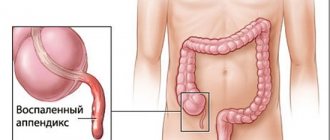Composition of the drug, release form, price
- Main substance: Omeprazole
- Excipients: Glycerin, nipagin, gelatin, nipazole, sodium lauryl sulfate, titanium dioxide, purified water, E 129 (dye).
Omeprazole is available in opaque hard capsules of 10, 20, 40 mg, consisting of 2 parts: one part is red and the other is white. The contents of the capsules are spherical pellets of white or light beige color.
10 capsules in strip packaging, 1, 2, 3 packs in a cardboard box. Also available in a polymer jar.
Price:
- 10 mg No. 28: 65-82 rubles;
- 20 mg No. 10: 29-30 rubles;
- 20 mg No. 20: 41-42 rubles;
- 40 mg No. 28: 131-154 rub.
pharmachologic effect
Omeprazole is a drug with an active antiulcer effect that inhibits the enzyme H+/K+-adenosine triphosphate (ATP) phase.
The action of omeprazole is associated with inhibition of the activity of this enzyme, another name for which is the proton pump. Deactivation of the enzyme occurs in the parietal cells of the stomach: the transfer of hydrogen ions necessary for the terminal stage of hydrochloric acid synthesis is blocked.
Omeprazole is a prodrug, i.e. acts as an active metabolite. Under the influence of the acidic environment of the tubules of gastric parietal cells, omeprazole is biotransformed within 2-4 minutes into sulfenamide, which reacts to block the membrane H+/K+ adenosine triphosphate (ATP) phase, connecting with the enzyme through a disulfide bridge.
This mechanism of action explains the high selectivity of the drug for parietal cells - they contain the environment necessary for the conversion of omeprazole into the active metabolite. In this case, sulfenamide is not absorbed because it is a cation.
- Omeprazole has a suppressive effect on the secretion of both basal and food-stimulated hydrochloric acid.
- Inhibits the production of pepsin and reduces the total volume of gastric secretion.
- In addition, omeprazole has gastroprotective activity of an unclear mechanism.
Does not affect the formation of internal factor of Castle and the speed of passage of food mass through the stomach into the duodenum; does not act on histamine and acetylcholine receptors.
The microgranules in the capsules are covered with a thin shell, the gradual release of which leads to:
- to the onset of action of the drug approximately 60 minutes after administration
- reaching therapeutic maximum after 120 minutes
- the effect of omeprazole lasts for a day or more
- inhibition of half the maximum gastric secretion while taking 20 mg of omeprazole continues throughout the day.
Thus, a single dose of omeprazole during the day quickly and effectively inhibits daytime and nighttime secretion of hydrochloric acid. The inhibitory effect becomes maximum after 4 days from the start of treatment. In patients with ulcerative lesions of the gastrointestinal mucosa, taking 20 mg of omeprazole leads to maintaining pH = 3 inside the stomach for 17 hours. Stopping omeprazole leads to the restoration of gastric secretory activity after 3-5 days.
Pharmacokinetics
Has high absorption. Bioavailability reaches 30-40%, increases in older people, and with insufficient liver function reaches 100%. The drug is highly lipophilic, as a result of which it easily enters parietal cells. It binds with plasma proteins (albumin and acidic alpha1-glycoprotein) up to 90-95%.
The half-life is about 0.5-1 hour, increases to 3 hours with insufficient liver function. Clearance - 500-600 ml/min. Metabolized in the liver almost completely, forming 6 inactive metabolites. Inhibits the CYP2C19 isoenzyme. About 70-80% of the drug is excreted by the kidneys, and 20-30% by bile.
Chronic renal failure and old age lead to a decrease in the rate of excretion of omeprazole in proportion to the decrease in the rate of creatine clearance.
Indications for use of Omeprazole
- Gastropathy during treatment with NSAIDs;
- Peptic ulcer of the stomach and duodenum, including those caused by Helicobacter pylori. Prescribed as anti-relapse treatment and in the acute phase.
- Reflux esophagitis, including the erosive form.
- Conditions occurring with hypersecretion of gastric juice: polyendocrine adenomatosis;
- Zollinger-Ellison syndrome;
- ulcers of the gastrointestinal tract due to stress;
- systemic mastocytosis.
Description of side effects
Omez and Omeprazo are proton pump inhibitors used to treat conditions such as ulcers, gastroesophageal reflux disease and Zollinger-Ellison syndrome, which are all caused by the level of acid produced affecting the stomach wall.
For maximum effectiveness, Omez and Omeprazole tablets should be taken before meals, swallowed whole and not chewed.
Omeprazole and Omez are available in capsule and tablet forms.
Side effects of medications may include headache, nausea, vomiting, diarrhea, stomach pain, gas, constipation, fever, or other symptoms such as a stuffy nose, sneezing, and sore throat.
Omez may potentially increase blood concentrations of Diazepam, Warfarin and Phenytoin by reducing the hepatic elimination of these drugs.
The absorption of some drugs may be affected by the acidity of the stomach, and as a result, Omeprazole and Omez, which reduce the amount of acid in the stomach, also reduce the absorption and blood concentration of Ketoconazole and increase the absorption and blood concentration of Digoxin.
As previously noted, Omeprazole or Omez is classified as proton pump inhibitors - drugs that block hydrogen ATPase enzymes found on the stomach wall.
Enzymes stimulate the production of stomach acid. An enlarged abdomen is a side effect of these medications.
Omeprazole and Omez can also cause liver failure. Omeprazole and Omez destroy liver cells, which leads to inflammation and swelling of the organ and pain in the upper right side of the abdominal cavity.
As liver failure progresses, patients develop a condition known as ascites, which leads to further enlargement of the abdominal cavity.
Ascites is an excess accumulation of fluid in the abdomen due to liver failure.
Other signs and symptoms of this disease include an enlarged or widened abdomen, yellowing of the skin and eyes, pain in the upper right side of the abdomen, loss of appetite, nausea, vomiting, malaise, dark urine and clay-colored stool.
Omeprazole and Omez cause excess gas to accumulate in the stomach and intestines, a condition known as abdominal bloating.
According to some studies, when excess gas is not released through belching or flatulence, it can accumulate in the stomach and intestines and cause bloating and pain in these organs.
Passing gas and having a bowel movement usually relieves this symptom. The foaming caused by Omeprazole and Omez is not harmful and goes away with continued use.
There are affordable and topical anti-bloating medications that patients can use if bloating becomes regular.
Long-term use of Omeprazole can cause the growth of polyps in the stomach.
Polyps are abnormal growths on the walls of the stomach that occur due to the suppression of stomach acid by Omez and other proton pump inhibitors.
Stomach polyps later develop into cancerous tumors. Stomach cancer causes swelling and fluid accumulation in the stomach. Tumors in the stomach can also cause the stomach to become enlarged.
Due to the presence of a number of side effects after taking the drug Omeprazole, it is recommended to visit a gastroenterologist who will determine the cause of stomach pain and prescribe appropriate treatment, as well as tell the patient how to take this or that medicine correctly.
Application, dosage
The capsules are intended to be taken orally as a whole. They are usually taken in the morning before meals, without chewing and with water. Omeprazole can be taken with food.
Exacerbation of ulcerative gastric ulcer and duodenum, gastropathy due to NSAIDs, reflux esophagitis
- 20 mg of omeprazole once a day.
- severe form of reflux esophagitis: 40 mg omeprazole once a day.
A course of treatment:
- duodenal ulcer: 2-4 weeks, can be extended to 4-5 weeks;
- PUD, reflux esophagitis, gastrointestinal lesions during NSAID therapy: 4-8 weeks.
Patients not sensitive to other antiulcer drugs
- 40 mg omeprazole per day. The course of treatment for duodenal ulcer is 4 weeks,
- PUD and reflux esophagitis – 8 weeks.
Use of omeprazole for the treatment of patients with liver failure:
The dose is reduced to 10-20 mg of the drug once a day. In severe forms, the daily dose should not be more than 20 mg. In patients with kidney pathologies and the elderly, no dose adjustment is required.
Others
- Zollinger-Elisson syndrome: 60 mg daily, it is permissible to increase the dose to 80-120 mg (in this case, it is divided into 2 doses).
- Prevention of exacerbations of peptic ulcer disease: 10 mg once a day.
- Eradication of the bacterium Helicobacter pylori: 20 mg of omeprazole 2 times a day (with parallel etiotropic therapy).
How to take for the stomach?
For stomach diseases, Omeprazole has the following positive effects:
- eliminates heartburn;
- relieves frequent sour belching;
- prevents bloating;
- prevents the development of gastritis.
Gastric diseases are often prevented using this drug. With its help, it is possible to avoid the development of an inflammatory process in the pancreas or recurrence of ulcers. Omeprazole is aimed at preventing internal bleeding in various diseases. The medicine is effective when the patient has severe stomach pain. In complex therapy, the drug is used by patients in critical condition, avoiding complications.
There are accessible rules for taking the drug in order to achieve the effect.
To get a positive result, you need to know how to take the drug correctly. It is not allowed to take the drug on an empty stomach; it is optimal to take it in the morning after meals. When capsules are prescribed, they are swallowed whole without chewing. An individual dosage is selected for each patient, depending on the severity of the stomach disease. Typically, you need to take 20 mg once a day. If necessary, the dose is increased to 40 mg as prescribed by the doctor. The duration of therapy for peptic ulcers is 28 days; for gastritis, they are treated with Omeprazole for 2 weeks.
Side effect
- Digestive organs: abdominal pain, diarrhea or constipation, nausea and vomiting, flatulence. Rarely, the activation of liver enzymes increases, taste distortion, stomatitis, and dry mouth mucous membranes appear. In patients with severe liver pathologies, hepatitis may develop.
- Nervous system: With concomitant somatic diseases in severe form, dizziness, headaches, depression, and agitation occur. In patients with severe liver pathologies, encephalopathy is possible.
- Musculoskeletal system: myasthenia gravis, arthralgia, myalgia rarely develop.
- Hematopoietic system: rarely - leukopenia, agranulocytosis, thrombocytopenia, pancytopenia.
- Skin: in rare cases - skin itching or rash, photosensitivity, exudative erythema multiforme, alopecia.
- Allergic reactions: angioedema, urticaria, fever, bronchospasm, anaphylactic shock.
- Other: rarely possible visual impairment, swelling of the extremities, malaise, increased sweating, gynecomastia, the formation of benign gastric glandular cysts of a reversible nature with long-term treatment.
Video about the use of omeprazole
Features of application
Omeprazole is usually taken before meals (at least 1 hour before meals). Follow all directions in the instructions. Do not take the drug in larger or smaller doses or for longer than recommended.
Over-the-counter omeprazole (Prilosec) should be taken once every 24 hours for 14 days. Take the medicine in the morning before breakfast. It may take up to 4 days to achieve full effect. Do not take more than one tablet every 24 hours.
At least 4 months must pass before starting another 14-day course of Prilosec therapy. Call your doctor if you have additional symptoms and need treatment before 4 months have passed.
There is no need to crush, chew, or break the enteric-coated tablet. Swallow the tablet whole.
You can open a time-release capsule and sprinkle the medication into a spoonful of applesauce to make it easier to swallow. Swallow the mixture immediately without chewing. It should not be left for later use.
Dissolve the powder in a small amount of water. You will need 1 teaspoon of water for a 2.5 mg packet or 1 tablespoon of water for a 10 mg packet. Leave the mixture for 2-3 minutes, then stir and drink immediately. To ensure you get the full dose, add a little more water to the same container, shake gently, and drink immediately.
Alternatively, the mixture can be administered through a nasogastric tube using only a catheter-tipped syringe. Shake the syringe well, then attach it to the tube and press the plunger so that the contents of the syringe flow into the tube. Fill the syringe with water and flush the tube to flush out the contents.
Use this medication completely for the prescribed period of time. Symptoms may improve before the illness goes away completely.
If you take omeprazole for more than 3 years, you may develop a vitamin B12 deficiency. Talk to your doctor about how to manage this problem.
Call your doctor if symptoms do not improve or get worse while using omeprazole.
Some problems are treated with a combination of omeprazole and antibiotics. Use all medications as prescribed by your doctor. Read the instructions for the medicine. Do not change the dose or schedule of your medication without consulting your doctor.
This medication may cause abnormal results on some medical tests. You may need to stop taking the drug for a short time before the test. Tell any doctor who treats you that you are taking omeprazole.
Store at room temperature away from moisture and heat.
Take the missed dose as soon as you remember. Skip the missed dose if it is almost time for your next scheduled dose. Do not take extra medicine to make up for missed doses.
In case of overdose, consult a doctor immediately.
Omeprazole may cause diarrhea, which may be a sign of a new infection. If diarrhea that is watery or bloody develops, contact your doctor. Do not use antidiarrheal medications unless directed by your doctor.
Side effects of omeprazole
Get emergency medical help if there are signs of an allergic reaction to omeprazole: hives; difficulty breathing; swelling of the face, lips, tongue, or throat.
Call your doctor right away if you experience:
- severe abdominal pain, diarrhea that is watery or bloody;
- convulsions;
- kidney problems - urinating more or less than usual, blood in the urine, swelling, accelerated weight gain;
symptoms of decreased magnesium levels – dizziness, confusion; fast or uneven heart rate; tremor (shaking) or muscle twitching; feeling of excitement; muscle spasms in the arms and legs; cough or feeling of choking.
Common side effects of omeprazole may include:
- stomach pain, gas;
- nausea, vomiting, diarrhea;
- headache.
This is not a complete list of side effects; others may occur. Ask your doctor about side effects.
What drugs can interact with omeprazole?
Ask your doctor if it is safe for you to take omeprazole if you are taking any of the following drugs:
- cilostazol;
- clopidogrel;
- digoxin;
- diazepam (Valium);
- disulfiram (antabuse);
- erlotinib;
- iron preparations (fumarate, gluconate, sulfate and others);
- methotrexate;
- mycophenolate mofetil;
- phenytoin;
- St. John's wort;
- tacrolimus;
- warfarin (Comadin, Jantoven);
- antibiotics such as ampicillin, amoxicillin, clarithromycin, rifampin;
- antifungals, for example, ketoconazole, voriconazole;
- drugs for HIV or AIDS, such as atazanavir, nelfinavir, saquinavir.
This list is not complete. Other drugs may interact with omeprazole, including prescription and over-the-counter medicines, vitamins, and herbal products. Not all potential interactions are listed in this drug information.
Consumer Information
Refers to omeprazole in the form of sustained-release capsules for oral administration, powder for suspension, sustained-release tablets for oral administration
In addition to its intended effects, omeprazole may cause adverse events that may require medical attention.
Severity: heavy
If any of the following side effects occur while taking omeprazole, consult your doctor immediately:
Rare:
- pain in the back, legs, stomach;
- bleeding or crusty sores on the lips;
- blisters;
- bloody or cloudy urine;
- chills;
- persistent mouth ulcers;
- difficulty, burning or pain when urinating;
- fever;
- frequent urge to urinate;
- a general feeling of discomfort or illness;
- joint pain;
- muscle pain or cramps;
- pain;
- red or irritated eyes;
- loss of appetite;
- redness, soreness, itching, peeling or burning of the skin;
- skin rash or itching;
- abnormal bleeding or bruising;
- sore throat;
- sores, sores or whitish spots in the mouth, lips or genitals;
- unusual tiredness or lethargy.
Prevalence unknown:
- drowsiness;
- fast, jumping or uneven pulse;
- mood or mental changes;
- muscle spasms or cramps;
- nausea or vomiting;
- tremor.
If any of the following symptoms of omeprazole overdose occur, get emergency help immediately:
Overdose symptoms:
- blurred vision;
- confusion;
- dry mouth;
- tides;
- headache;
- increased sweating.
Severity: light
Some of the unwanted effects that may occur while taking omeprazole do not require medical attention. As your body gets used to the medicine during treatment, these side effects may go away. A specialist can tell you how to reduce or prevent some of these unwanted effects. If any of them persist, cause discomfort, or you have questions, consult a healthcare professional.
Less common:
- body pain;
- chest pain;
- constipation;
- cough;
- diarrhea;
- labored breathing;
- dizziness;
- ear congestion;
- gases;
- heartburn;
- loss of voice;
- muscle pain;
- nasal congestion;
- runny nose;
- sneezing;
- unusual drowsiness.
Information for professionals
Refers to omeprazole powder for mixing, sustained-release capsules for oral administration, delayed-release tablets for oral administration, powder for reconstitution, powder for preparation of sustained-release solution, oral suspension
Are common
Omeprazole is usually well tolerated. Any drug that increases the pH in the stomach can stimulate the release of gastrin. Animal studies have shown an increase in plasma gastrin concentrations after administration of omeprazole. In addition, long-term animal studies revealed a dose-related increase in the prevalence of gastric enterochromaffin-like cells. This has raised concerns about the safety of long-term use of omeprazole in humans. However, to date, long-term human studies of up to six years have not revealed any hint of carcinoid formation in the stomach due to the use of omeprazole.
In humans, plasma gastrin levels rise within a few days of initial treatment, typically reaching a maximum by 2–4 months of treatment. Typically the increase is 2-4 times the baseline, although in some patients gastrin levels become more than 10 times normal. Hyperplasia of gastric enterochromaffin-like cells has been observed with long-term use, but no signs of dysplasia, carcinoid tumors or other neoplastic changes have been observed in humans.
Gastrointestinal
Gastric polyposis was reported in 3 of 11 patients on long-term omeprazole therapy (20 to 40 mg per day). These patients developed polyps of the hyperplastic and fundic glands in the stomach. Dysplasia and malignancy were not noted. The significance of these findings from a small case series is unknown. Controlled studies are needed to fully evaluate this effect.
Gastrointestinal adverse effects included diarrhea (3.0-3.7%), abdominal pain (2.4%), nausea (2.2-4%), vomiting (1.5-3.2%), constipation (1.1%), anorexia, colon irritation, excess gas production, dry mouth, esophageal candidiasis, and persistent achlorhydria in patients with Zollinger-Ellison syndrome. Gastric polyps, gastric enterochromaffin cell hyperplasia, and atrophic gastritis have been reported after long-term therapy. Enteritis caused by Campylobacter
, was identified in one case-control study.
Rare cases of pancreatitis, some fatal, have been reported during the post-marketing period.
Endocrine
Endocrine side effects include gynecomastia, breast enlargement in women, and breast tenderness.
Hepatic
Hepatic side effects include increased serum levels of transaminases, bilirubin, alkaline phosphatase, and rare cases of hepatitis and hepatic encephalopathy. Fatal fulminant liver failure has also been reported in association with omeprazole.
Renal
Renal side effects include increased serum creatinine and rare reports of interstitial nephritis and renal failure.
Hematological
The absorption of cyanocobalamin (vitamin B12) was studied before and after administration of omeprazole 20 mg or 40 mg per day for 14 days in 10 healthy subjects. Omeprazole caused a dose-dependent decrease in the absorption of protein-bound cyanocobalamin. Since the effect of long-term omeprazole therapy on the distribution of cyanocobalamin is unknown, it may be prudent to monitor cyanocobalamin levels in patients receiving long-term omeprazole therapy.
Hematological side effects - rare reports of hemolytic anemia, pancytopenia, thrombocytopenia, neutropenia, anemia, agranulocytosis and leukocytosis.
Respiratory
Respiratory side effects include cough and rare reports of sore nose and throat.
Nervous system
Nervous side effects are mainly headaches, drowsiness, dizziness, vertigo, hemifacial dysesthesia and numbness, limb paresthesia, and seizures. Reversible ataxia has also been reported.
Cardiovascular
Side effects in the cardiovascular system were rarely recorded. These include angina, bradycardia, tachycardia, palpitations, hypertension and peripheral edema.
Dermatological
Dermatologic adverse effects included rash and rare reports of itching, alopecia, dry skin, sweating, and cases of disseminated epidermal necrolysis, furunculosis, and erythroderma. At least one case of vasculitis was reported, in addition to a case of dermatomyositis.
Hypersensitivity
Allergic side effects included urticaria and angioedema. One case of anaphylaxis has been documented with the second use of omeprazole.
Metabolic
Metabolic side effects included hypoglycemia, hyponatremia, weight gain, and increased uric acid levels. Additionally, it has been reported that omeprazole may cause hypomagnesemia if taken for extended periods of time (more than 1 year in most cases). Patients who develop hypomagnesemia may experience seizures, dizziness, abnormal, fast or skipped heartbeats, twitching or tremors, muscle weakness, arm and leg cramps, muscle cramps or pain, or spasm of the larynx.
Psychiatric
Psychiatric adverse effects have been reported rarely. These include depression, nervousness, hallucinations, insomnia, anxiety, sleep disturbances and apathy.
Genitourinary
Genitourinary adverse events included impotence and rare reports of urinary tract infections, pyuria, urinary frequency, proteinuria, hematuria, glycosuria and testicular pain.
Musculoskeletal system
The risk of hip fracture is significantly increased among patients taking high-dose proton pump inhibitors for a long time.
Musculoskeletal side effects included the development of nonspecific polyarthritis, which appears to resolve after discontinuation of omeprazole. Fractures of femurs and other bones have been reported. At least one case of acute severe myopathy was reported.
Immunological
Immunological side effects have been reported rarely. These included an autoimmune disorder with development of fever, arthralgia, Raynaud's phenomenon, and a positive ANA titer.
Dosing
Usual Adult Dose for Duodenal Ulcer
20 mg orally once daily before meals. In most cases, cure occurs within 4-8 weeks.
Usual Adult Dose for Helicobacter pylori infection
Dual therapy: omeprazole 40 mg orally once a day in the morning in combination with clarithromycin 500 mg orally 3 times a day on days 1 to 14. Starting from the 15th day, omeprazole 20 mg orally once a day in the morning on days 15 to 28.
Triple therapy: omeprazole 20 mg in combination with clarithromycin 500 mg and amoxicillin 1000 mg, all orally, 2 times a day for 10 days. If an ulcer is present at the start of therapy, omeprazole 20 mg orally once daily should be continued for 18 days.
Usual Adult Dose for Stomach Ulcer
40 mg orally once daily before meals for 4-8 weeks.
Usual Adult Dose for Erosive Esophagitis
20 mg orally once daily before meals. This dose may be increased to 40 mg per day based on the desired clinical response and patient tolerance.
Usual Adult Dose for Treatment of Zollinger-Ellison Syndrome
Initially: 60 mg orally once daily. The dosage should be selected individually according to the patient's needs.
Maintenance dose: up to 120 mg 3 times a day. Daily doses greater than 80 mg should be divided.
Usual Adult Dose for Gastroesophageal Reflux Disease
Initially: 20 mg PO once daily before meals for 4 to 8 weeks. This dose can be increased to 40 mg per day if necessary.
Maintenance dose: Long-term treatment with doses of 10-20 mg per day may be required for maintenance treatment of persistent disease and is safe.
Usual Adult Dose for Multiple Endocrine Tumors
Initially: 60 mg PO once daily before meals. This dose may be titrated depending on the desired clinical response and patient tolerance.
Maintenance dose: doses up to 120 mg 3 times a day. Daily doses greater than 80 mg should be divided.
Usual Adult Dose for Systemic Mastocytosis
Initially: 60 mg PO once daily before meals. This dose may be titrated depending on the desired clinical response and patient tolerance.
Maintenance dose: doses up to 120 mg 3 times a day. Daily doses greater than 80 mg should be divided.
Usual Adult Dose for Dyspepsia
Prevention of frequent heartburn: 20 mg orally once a day, before meals, for 14 days.
Children and adolescents aged 1-16 years with GERD, ulcers, esophagitis
Manufacturer's recommendations:
- Weight 5-10 kg: 5 mg once daily
- Weight 10-20 kg: 10 mg once daily
- Weight over 20 kg: 20 mg once daily
Alternative dosage:
- Children and adolescents aged 1-16 years: 1 mg/kg/dose once or twice daily
Adjunctive therapy for duodenal ulcers caused by Helicobacter Pylori
(in combination with antibacterial therapy with clarithromycin or clarithromycin and amoxicillin) in children:
- Weight 15-30 kg: 10 mg twice daily
- Weight over 30 kg: 20 mg twice daily
Comment: The safety and effectiveness of omeprazole in patients less than 1 year of age and for use other than the treatment of GERD and maintenance of healing of erosive esophagitis have not been established.
Renal dose adjustment
No recommendations.
Hepatic dose adjustment
The manufacturer recommends dose adjustment in patients with impaired liver function, especially if it is necessary to support the healing of erosive esophagitis.
Dose adjustment
For an over-the-counter product, the manufacturer advises not to use the drug for more than 14 days in a row. The 14-day course can be repeated only once every 4 months.
Drug interactions
- Reduces the absorption of iron salts, ampicillin esters, itraconazole and ketoconazole.
- May increase the blood concentration of the following drugs: diazepam, anticoagulants with indirect action, phenytoin, clarithromycin. These groups of drugs are metabolized in the liver using the cytochrome CYP2C19 enzyme, which is inhibited by omeprazole.
special instructions
Before use, gastrointestinal cancer pathology must be excluded, since omeprazole can erase symptoms and thus delay the correct diagnosis.
Overdose
Confusion, drowsiness, blurred vision, dry mouth, nausea, arrhythmia, tachycardia, and headache are observed. There is no specific antidote, treatment is symptomatic.











